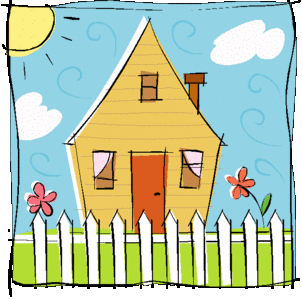How do you live? Don’t design your house for the people that may live in it after you. Design it for how you live. If you don’t plan on living there long, you may want to consider what the house will need for selling (enough bedrooms and bathrooms, for example, or a dishwasher), but mostly this should be about you, what you want, what you need, but most importantly, how you live. Be honest with yourself about your clutter habits, how often you watch TV, and how you move from room to room.
Main Living Areas. Do you spend most of your time in the main living areas such as the kitchen, living room, and dining room? Consider one open area with all three. Do you spend most of your time in your home office? If you want to be involved in the other goings on of your house, keep the office close to the main living areas. Otherwise consider a quiet corner in another part of the house.
Bathrooms and Closets. How many people will live in your house? Everyone may not need their own bathroom, but more than one bathroom might be a good idea. Do you want to luxuriate in your own private bath, or do you just use it merely to get clean and then you’re outta there? Size the bathroom accordingly. Similarly, do you have a ton of clothes and need a walk-in closet? Or do you have just enough clothes to get by and would be happy with something smaller?
Bedrooms. How big do you need your bedroom to be? Do you use it only for sleeping and dressing, or do you like to spend time in there during any part of the day? If you like to spend a lot of time in there, you may need a larger room, with a spot for a sitting area and table, or exercise equipment, or other items. Make sure there is plenty of room to walk around the bed and other furniture, even if you end up with dirty clothes on the floor! If you have children, make sure their rooms are large enough for them to spend time in during the day, as that will be their own private space.
How the Space Feels. When you’re in other houses and discover a space that makes you feel at home, note the details. How large is the space? How many windows? How high is the ceiling? What is the color scheme? If you find a space that makes you very uncomfortable, also note those details, so you can avoid them in your design.
Storage and Tidiness. The best way to keep a house tidy is to have a place for everything, and put everything in its place. Be sure to allow for enough storage in your house, in the form of a storage room, closets, cupboards, kitchen cabinets, bookcases, etc. It’s better to have slightly too much storage than not enough.
Ceiling Height. Do you really enjoy very high ceilings, or do they make you feel tiny? High ceilings can make a big statement, but they cost more and don’t work for small rooms. If you prefer cozy spaces where you can curl up with a good book or have intimate conversations with loved ones, lower ceilings (usually 8 foot ceilings or sometimes lower for small nooks) may be the better way to go. But if the room is very large, a low ceiling may feel claustrophobic.
Special Furniture. Be sure to measure all the furniture you want to move to your new house, and make sure it will fit in the arrangements you plan for your rooms. You may even want to design spaces or nooks to fit special pieces of furniture or art that you want to showcase in the new place.
House Size. Most people want a larger home, but sometimes it is better to have a smaller home that is better designed. Examine how you use each room that you currently have, and use that information to design the new house. Aim to use almost every room in the new house on a daily basis. Yes, even guest rooms. If you want a guest room, try to also use it for another purpose, such as for sewing, an office, or other self-contained task.
Windows. When you plan your window placement, consider not only how it will look from inside the house, but also how the windows will all look together on the outside of the house. Also, consider what your view would be from each window. If there is a beautiful view that can only be had from one spot, try to put a window there.
Extras. All around the house, remember to plan spaces for items like laundry baskets, trash cans, wet boots and umbrellas, and other small necessities. Planning your house right down to the last detail with no room for flexibility will probably mean you won’t have room for the one or two items you forgot to plan for.
Pulling the House Together. Try to have one cohesive look for most of your house. Unless it’s been your life’s dream, I wouldn’t recommend a modern exterior and Victorian interior. Your exterior may be determined or influenced by any Home Owner’s Association CC&Rs;, or just by the other types of house in the neighborhood, or you may be free to build what you want. Try to have the interior rooms of a similar style, especially when you can see one room from another.
Budget. It is said that you should budget 10% less than you can afford for building your house, as things will always turn out to be more expensive than you plan. You may change things at the last minute, or the cheap flooring you found may no longer be available. You don’t want to be almost done building the house and find out that you have run out of money.
If you do plenty of research and design your house for how you actually live, including colors that you like, areas that draw you in, and features that finish it all to your liking, you should love your new house. Take pride in doing a lot of the design yourself. You don’t need to be an architect to make some decisions about how the rooms will be laid out. If you don’t have the knowledge to draw up the final plans, an architect or draftsperson can work with the floor plan you’ve designed and complete the final plans. Enjoy the process, and imagine the possibilities!




